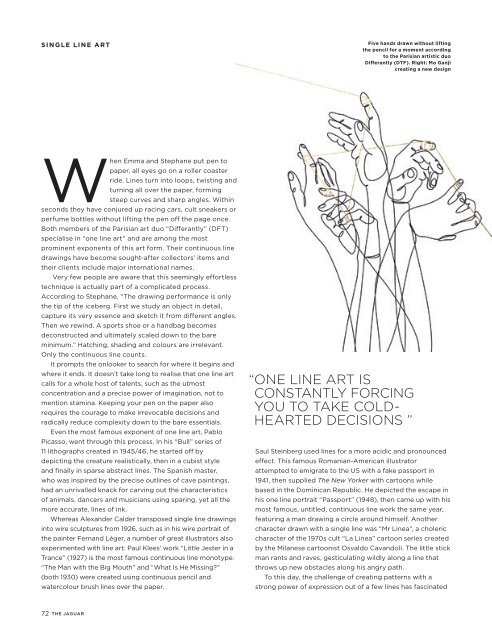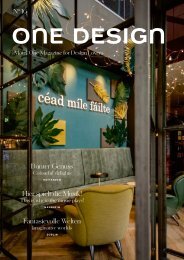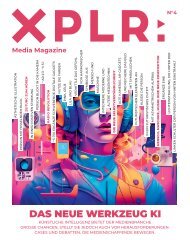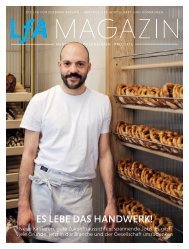Jaguar Magazine 03/2017 – English
Wir geben Gas! In London sorgt Automobiljournalist Guy Bird im brandneuen E-PACE für Aufsehen und zeigt uns ganz nebenbei nahezu unentdeckte Tipps in der britischem Hauptstadt – seiner Heimat. Warum sich der Jaguar XE bestens als Grundlage für den leistungsstärksten Jaguar mit Straßenzulassung aller Zeiten – den XE SV Project 8 – geeignet hat, hat uns David Pook erklärt, Leiter der Special Vehicle Operations bei Jaguar Land Rover. Lesen Sie mehr in der aktuellen Ausgabe THE JAGUAR 03.
Wir geben Gas! In London sorgt Automobiljournalist Guy Bird im brandneuen E-PACE für Aufsehen und zeigt uns ganz nebenbei nahezu unentdeckte Tipps in der britischem Hauptstadt – seiner Heimat. Warum sich der Jaguar XE bestens als Grundlage für den leistungsstärksten Jaguar mit Straßenzulassung aller Zeiten – den XE SV Project 8 – geeignet hat, hat uns David Pook erklärt, Leiter der Special Vehicle Operations bei Jaguar Land Rover.
Lesen Sie mehr in der aktuellen Ausgabe THE JAGUAR 03.
Create successful ePaper yourself
Turn your PDF publications into a flip-book with our unique Google optimized e-Paper software.
SINGLE LINE ART<br />
Five hands drawn without lifting<br />
the pencil for a moment according<br />
to the Parisian artistic duo<br />
Differantly (DTF). Right: Mo Ganji<br />
creating a new design<br />
When Emma and Stephane put pen to<br />
paper, all eyes go on a roller coaster<br />
ride. Lines turn into loops, twisting and<br />
turning all over the paper, forming<br />
steep curves and sharp angles. Within<br />
seconds they have conjured up racing cars, cult sneakers or<br />
perfume bottles without lifting the pen off the page once.<br />
Both members of the Parisian art duo “Differantly” (DFT)<br />
specialise in “one line art” and are among the most<br />
prominent exponents of this art form. Their continuous line<br />
drawings have become sought-after collectors’ items and<br />
their clients include major international names.<br />
Very few people are aware that this seemingly effortless<br />
technique is actually part of a complicated process.<br />
According to Stephane, “The drawing performance is only<br />
the tip of the iceberg. First we study an object in detail,<br />
capture its very essence and sketch it from different angles.<br />
Then we rewind. A sports shoe or a handbag becomes<br />
deconstructed and ultimately scaled down to the bare<br />
minimum.” Hatching, shading and colours are irrelevant.<br />
Only the continuous line counts.<br />
It prompts the onlooker to search for where it begins and<br />
where it ends. It doesn’t take long to realise that one line art<br />
calls for a whole host of talents, such as the utmost<br />
concentration and a precise power of imagination, not to<br />
mention stamina. Keeping your pen on the paper also<br />
requires the courage to make irrevocable decisions and<br />
radically reduce complexity down to the bare essentials.<br />
Even the most famous exponent of one line art, Pablo<br />
Picasso, went through this process. In his “Bull” series of<br />
11 lithographs created in 1945/46, he started off by<br />
depicting the creature realistically, then in a cubist style<br />
and finally in sparse abstract lines. The Spanish master,<br />
who was inspired by the precise outlines of cave paintings,<br />
had an unrivalled knack for carving out the characteristics<br />
of animals, dancers and musicians using sparing, yet all the<br />
more accurate, lines of ink.<br />
Whereas Alexander Calder transposed single line drawings<br />
into wire sculptures from 1926, such as in his wire portrait of<br />
the painter Fernand Léger, a number of great illustrators also<br />
experimented with line art: Paul Klees’ work “Little Jester in a<br />
Trance” (1927) is the most famous continuous line monotype.<br />
“The Man with the Big Mouth” and “What Is He Missing?”<br />
(both 1930) were created using continuous pencil and<br />
watercolour brush lines over the paper.<br />
“ONE LINE ART IS<br />
CONSTANTLY FORCING<br />
YOU TO TAKE COLD-<br />
HEARTED DECISIONS ”<br />
Saul Steinberg used lines for a more acidic and pronounced<br />
effect. This famous Romanian-American illustrator<br />
attempted to emigrate to the US with a fake passport in<br />
1941, then supplied The New Yorker with cartoons while<br />
based in the Dominican Republic. He depicted the escape in<br />
his one line portrait “Passport” (1948), then came up with his<br />
most famous, untitled, continuous line work the same year,<br />
featuring a man drawing a circle around himself. Another<br />
character drawn with a single line was “Mr Linea”, a choleric<br />
character of the 1970s cult “La Linea” cartoon series created<br />
by the Milanese cartoonist Osvaldo Cavandoli. The little stick<br />
man rants and raves, gesticulating wildly along a line that<br />
throws up new obstacles along his angry path.<br />
To this day, the challenge of creating patterns with a<br />
strong power of expression out of a few lines has fascinated<br />
72 THE JAGUAR


















